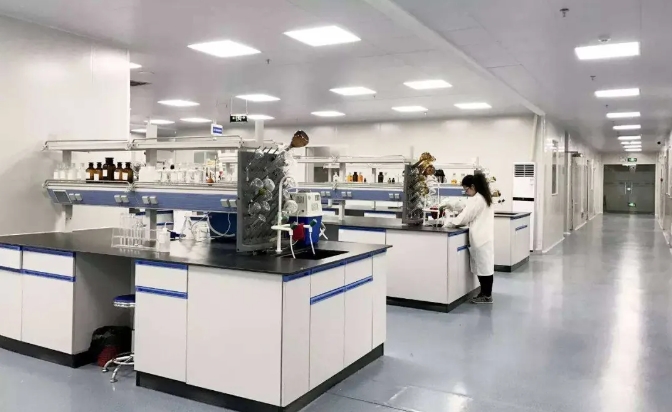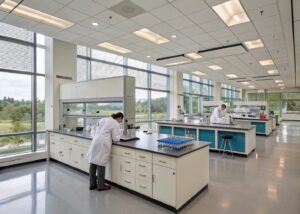Table of Contents
How to Design an Environmental Testing Lab: A Comprehensive Guide
Designing an environmental testing lab requires meticulous planning, careful attention to safety standards, and a focus on functionality. Environmental testing labs are essential for monitoring pollutants and ensuring that environmental quality is maintained. Whether you’re a lab owner looking to build a new facility or a designer tasked with creating an efficient space, understanding the specific needs of the lab is crucial for success. This article will guide you through the key considerations for creating a high-performance environmental testing lab that meets regulatory standards and enhances operational efficiency.
Planning the Layout: A Critical First Step
The first and most important step in environmental testing lab design is planning the layout. Proper space allocation and functional zoning are key to maintaining safety, efficiency, and accuracy in testing results. When designing the layout, consider the following:
Separate Functional Areas
- Sample Preparation Area: This is where environmental samples (water, air, soil) are prepped for analysis. Ensure that this area is spacious, well-ventilated, and isolated from the rest of the lab.
- Experimental Operation Area: This section is where most of the testing and analysis takes place. It should be equipped with the necessary instruments and have easy access to sample preparation and storage areas.
- Instrument and Equipment Zones: These areas house high-tech instruments such as spectrometers, gas chromatographs, and ICP-MS machines. The space should be designed with proper ventilation and climate control.
- Office Spaces: While often overlooked, office spaces are essential for data analysis and report writing. Make sure they are separated from the lab areas to avoid contamination and noise.
Materials Selection for Lab Surfaces
The surfaces in an environmental testing lab must be durable and resistant to harsh chemicals. Use acid-resistant, alkali-resistant floor tiles and fire-resistant wall materials to ensure longevity and safety. This also makes cleaning and maintaining the lab much easier, contributing to accurate testing conditions.
Ventilation System Design: Ensuring Safety and Air Quality
An environmental testing lab often deals with harmful chemicals and gases. A robust ventilation system is essential to maintain air quality, remove toxic fumes, and protect the health of lab personnel. Here’s what to consider when designing the ventilation system:
Three Key Components:
- Air Intake: Fresh air must be supplied continuously to keep the lab environment safe and comfortable.
- Exhaust: Toxic gases and fumes must be safely extracted from the testing areas. A specialized exhaust system for zones that handle hazardous chemicals is vital.
- Air Filtration: Filters should be installed to trap particulate matter and purify the air before it is vented outside.
Proper airflow also ensures the accuracy of testing results by preventing cross-contamination between different testing areas. Additionally, the ventilation system should be energy-efficient and designed to minimize noise without compromising performance.
Safety Considerations: Protecting Personnel and Equipment
Safety is paramount in any environmental testing lab design. Here are the key safety measures to include:
Door Orientation and Material
In general laboratories, doors open inward, but rooms dealing with explosion hazards should have doors that open outward for quick evacuation. Using pressure glass in doors is recommended for added protection.
Fire Safety
Fire hazards are a significant risk in labs dealing with volatile chemicals. Ensure that the lab is equipped with fire detection and suppression systems. All staff should be trained in emergency procedures, and fire exits should be easily accessible.
Chemical Storage
A well-ventilated, temperature-controlled chemical storage room is critical. Segregate chemicals by type (flammable, corrosive, etc.), and ensure that proper labeling and containment measures are in place to prevent accidents.
Electrical and Power Considerations
Environmental testing labs often rely on advanced equipment that consumes significant amounts of power. When planning the electrical layout, it’s important to account for the specific needs of your equipment:
High Power Demand Equipment
Instruments like spectrometers, gas chromatographs, and ICP-MS machines can require power loads of 6kW or more. Ensure that power points are capable of handling this load, and avoid placing high-power consumption devices on the same circuit as office equipment.
Backup Power Supply
To prevent downtime during critical tests, install backup power systems such as uninterruptible power supplies (UPS) or generators. This ensures that sensitive instruments are not damaged during power outages, and data integrity is maintained.
Specialized Room Design for Environmental Testing Labs
In addition to standard lab areas, environmental testing lab design often includes specialized rooms that require additional planning:
Cold Storage Room
Used for storing temperature-sensitive samples, this room must be temperature-regulated and have backup power in case of power failures.
Sterile Rooms
Sterile environments are needed for certain biological testing. These rooms should have advanced air filtration systems and be kept isolated from other testing areas to prevent contamination.
BOD Constant Temperature and Humidity Rooms
Biochemical Oxygen Demand (BOD) testing requires constant temperature and humidity control. These rooms need to be equipped with precise environmental controls to ensure test accuracy.
Gas Cylinder Room
If your lab uses compressed gases, ensure that they are stored in a separate, ventilated room with appropriate safety measures like gas detectors and fire suppression systems.
Compliance with Regulations and Standards
To ensure your environmental testing lab design is compliant, consult with regulatory bodies early in the planning process. Local and international standards for environmental labs often dictate specific requirements for ventilation, chemical storage, and waste management.
Having a quality management system in place is also essential for accreditation. It ensures that your lab meets regulatory standards and consistently produces reliable results. Implementing good lab practices (GLP) and ISO standards will also enhance your lab’s credibility and efficiency.
Conclusion
Designing an efficient and compliant environmental testing lab is a complex process that requires careful planning, attention to safety, and compliance with regulations. From strategic layout planning to advanced ventilation systems, each element must be tailored to meet the specific needs of environmental testing. By following these guidelines, lab owners and designers can create a functional and safe lab environment that produces accurate, reliable test results while protecting staff and the environment.




